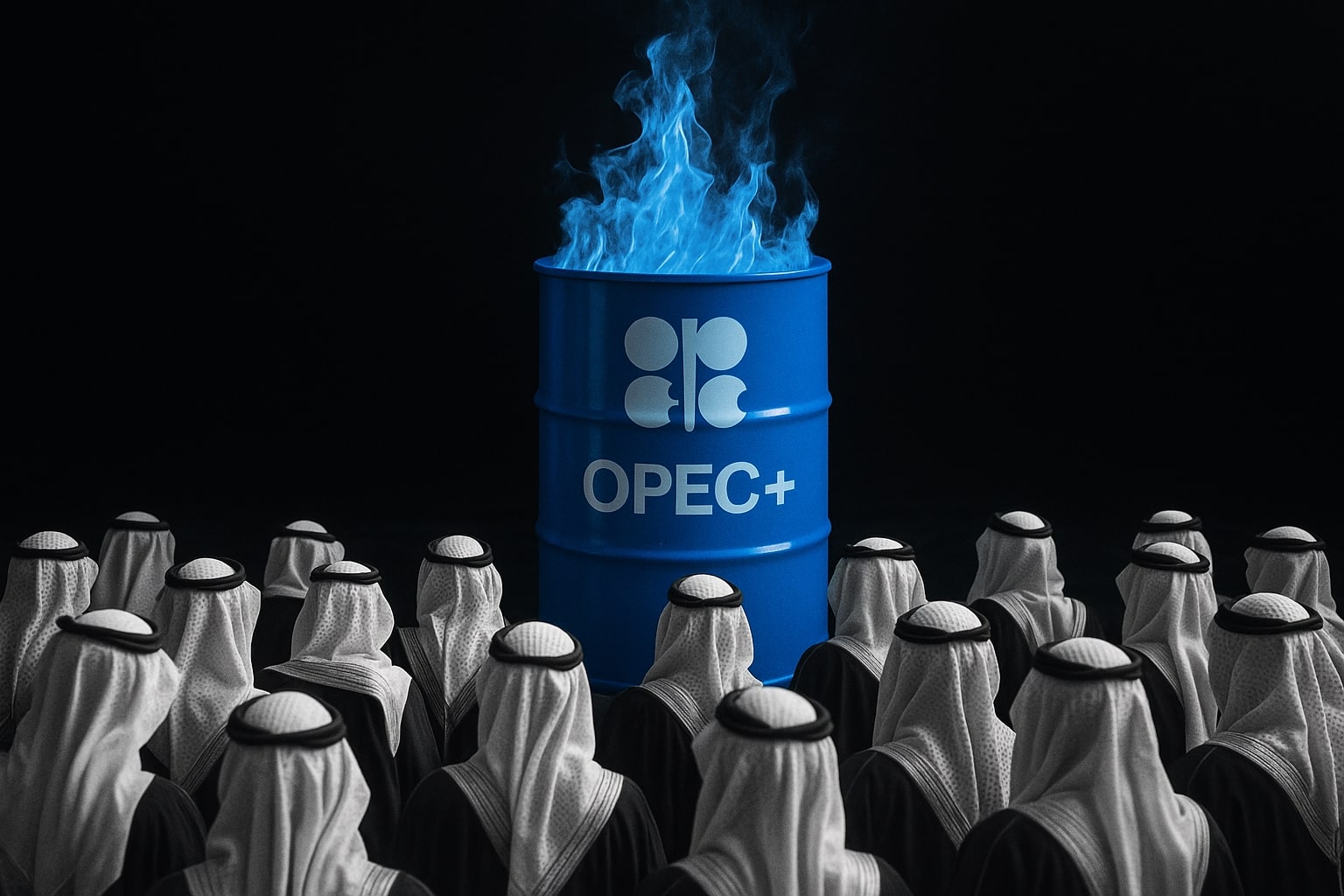
Oil Price Forecast - Oil Prices (CL=F, BZ=F) Sink to $59.80 WTI and $63.73 Brent as Inventories Swell
WTI (CL=F) trades at $59.80 while Brent (BZ=F) holds $63.73, pressured by record output of 13.3M bpd in the U.S., weak demand, and OPEC+’s production pause into 2026 | That's TradingNEWS
Oil Market (CL=F, BZ=F) Faces Tightrope Between Oversupply and Geopolitical Risk as Prices Hover Near $60
Crude oil entered the second week of November under renewed downward pressure, with West Texas Intermediate (CL=F) trading near $59.80 and Brent (BZ=F) stabilizing around $63.73. The global market finds itself caught between record production levels, swelling inventories, and political disruptions from Iraq to Russia, leaving traders balancing a tangible supply glut against geopolitical risk premiums that refuse to fully fade.
The short-term tone remains bearish as the U.S. Energy Information Administration (EIA) confirmed a 5.2 million-barrel build in crude inventories for the week, while gasoline stocks fell 4.7 million barrels, a divergence that signals waning refining throughput amid fragile demand. At the same time, the number of barrels held in floating storage across Asian waters doubled, as sanctions-related cargoes rerouted from Russia’s export network continue to flood regional markets.
WTI (CL=F) Anchored Below $60 as Oversupply Turns Structural
The persistent buildup of seaborne arrivals—up 18% week-over-week—has become the defining driver of sentiment. Data from Vortexa show crude-on-water volumes rising sharply through November, signaling that the long-anticipated glut is no longer theoretical but actively landing at global terminals. Each arrival adds to an already saturated system of onshore storage nearing 70–75% utilization, making price recovery efforts increasingly fragile.
Over the past four months, WTI crude has fallen 13.7%, retracing every attempt to rebound. Despite temporary rallies, no sustained buying emerged below $60, with technical resistance thickening between $61.50 and $62.00, where the 50-day EMA caps every upside attempt. The market continues to respect the psychological $60 level as the pivot point separating routine correction from capitulation.
Analysts describe this setup as a “draining glut” — oil that spent months at sea is now being absorbed into global tanks, effectively crystallizing the oversupply narrative. This phase typically precedes a washout event, where short-term capitulation sets the stage for longer-term value re-entry.
Brent (BZ=F) Finds Resistance at $65 While Demand Weakens in Asia
For Brent crude (BZ=F), resistance remains entrenched at $65.00, where the 50-day EMA converges with a prior distribution zone that repeatedly triggered sell-offs in October. Traders note that the $66.50 mark aligns with the 200-day EMA, forming a critical ceiling that must be breached to reverse the medium-term downtrend.
Asian demand—particularly from India and China—remains a wildcard. India, pressured by new U.S. sanctions on Russia’s Rosneft and Lukoil, has shifted sourcing aggressively, purchasing 5 million barrels from the U.S., Iraq, and UAE for January delivery. The urgency to diversify underscores how sanctions are reshaping global crude flows rather than reducing total trade volume. Meanwhile, China’s crude imports rose sharply last month, but its industrial commodity demand fell, showing that refineries are restocking rather than consuming more fuel.
Even as Lukoil declared force majeure at Iraq’s West Qurna-2 field, the event failed to spark a significant price rally, proving that traders see the sanction disruption as temporary rather than structural.
OPEC+ Signals Pause but Production Discipline Remains Elusive
The latest OPEC+ meeting produced a cautious statement: output increases will pause in Q1 2026, but the group also confirmed a modest December hike. While intended to balance supply, this dual message sowed uncertainty, as the market interpreted the pause not as bullish restraint but as acknowledgment of saturated conditions.
OPEC+ currently pumps near 43.2 million barrels per day (bpd), with the U.S. and Brazil contributing record non-OPEC additions. U.S. output hit an all-time high above 13.3 million bpd, while floating storage volumes in Asia reached their highest in over 18 months. The result is a surplus estimated at 0.8–1.0 million bpd heading into winter, a reversal from early-year deficits.
Despite geopolitical volatility—from sanctions to tanker reroutes—the structural oversupply now defines the pricing curve. Forward spreads have flattened, with WTI December 2025 contracts pricing only marginally higher than front-month barrels, reflecting a market braced for low volatility rather than panic.
Read More
-
JEPQ ETF (NASDAQ:JEPQ) Climbs Toward $59 as 10.3% Yield and $31B AUM Cement Its Status as JPMorgan’s Income Powerhouse
10.11.2025 · TradingNEWS ArchiveStocks
-
XRPI & XRPR ETFs Rally Over 8% as XRP Trades Above $2.53 — DTCC Listings Ignite Institutional XRP ETF Boom
10.11.2025 · TradingNEWS ArchiveCrypto
-
Natural Gas Price (NG=F) Surges Above $4.40 as Record LNG Exports and Tight Storage Ignite Bullish Winter Rally
10.11.2025 · TradingNEWS ArchiveCommodities
-
USD/JPY Price Forecast - Dollar/Yen Steadies Near 154.00 as U.S. Fiscal Optimism Offsets BoJ Policy Caution
10.11.2025 · TradingNEWS ArchiveForex
Political Developments Add Short-Lived Volatility
Washington’s legislative progress on ending the 40-day federal shutdown injected temporary optimism into global risk assets, sending WTI briefly above $60.20 before retreating. The U.S. Senate’s advancement of the funding bill improved risk appetite, though the parallel spike in flight cancellations (2,800 canceled, 10,200 delayed) dampened jet fuel demand forecasts. Analysts expect this to remain a transient drag, with air traffic normalization likely within two weeks.
Simultaneously, India’s President Droupadi Murmu underscored a long-term strategy to secure oil supply from Angola, signaling that emerging economies are adapting their import portfolios faster than expected. This diversification reduces OPEC leverage, amplifying supply elasticity, and thus further constraining price rallies.
Corporate and Regional Activity: Eni, Petronas, and Lukoil Redraw the Map
In the corporate sphere, Eni (BIT:ENI) and Petronas announced plans to initiate eight upstream projects across Indonesia and Malaysia within three years, with $15 billion in first-phase investments and a combined production base of 300,000 boe/d expanding toward 500,000 boe/d. The venture aligns with Eni’s “satellite model” that clusters regional projects into semi-independent joint ventures, echoing its strategies in Angola, Norway, and the U.K.
Meanwhile, the collapse of Gunvor’s bid for Lukoil’s Iraqi assets and the U.S. Treasury’s labeling of the trader as a “Russian puppet” highlight the chilling effects of Western sanctions. Lukoil’s West Qurna-2 suspension removes an estimated 380,000 bpd from Iraq’s short-term output but is being offset by increased production from Basra and Murban grades destined for Indian refiners.
Volatility Outlook and Technical Metrics for CL=F and BZ=F
The CBOE Crude Oil Volatility Index (OVX) remains suppressed near 34, significantly below its 2024 average of 46, reflecting complacency despite escalating supply signals. Historically, such low volatility in the face of inventory expansion often precedes a sharp repricing event. Analysts see OVX resistance at 72 as the trigger zone for a renewed volatility spike, should crude break below $58.
On the charts, WTI December futures exhibit layered support between $58.00 and $55.00, matching the YVWAP and QVWAP trend zones, while overhead resistance remains firm at $61.50. The medium-term projection points to a potential retest of $52 before structural value buying returns.
For Brent, the key thresholds lie between $63.50–$66.50, with sustained closes below $63 likely to confirm a drift toward $60, its next liquidity pocket. Without a significant policy shift from OPEC+ or a supply disruption event exceeding 500,000 bpd, technical pressure favors gradual declines rather than rallies.
Global Trade and Floating Storage Trends Reinforce Bearish Bias
Maritime analytics show floating storage volumes rising for the fifth consecutive week. The Asian seaborne fleet now holds over 200 million barrels of crude—double early October levels. As these barrels make landfall, global inventory will likely exceed 4.5 billion barrels, nearing the mid-2023 peak that triggered a similar downturn cycle.
Even with the U.S. Strategic Petroleum Reserve buying token volumes to stabilize domestic prices, commercial inventory growth remains the dominant narrative. The EIA’s projection for the fourth quarter anticipates a modest 0.4% increase in demand but a 1.8% rise in supply, ensuring that the imbalance persists through early 2026.
Institutional and Trading Behavior Shifts: From Fear to Patience
Hedge fund data remains incomplete due to the U.S. government shutdown, but ICE positioning for Brent indicates reduced speculative longs and rising commercial hedges. The ratio of speculative long to short positions has fallen to 1.3:1, its lowest since February, suggesting funds are exiting rather than shorting aggressively.
Major oil firms, meanwhile, are recalibrating. ExxonMobil (NYSE:XOM) expanded its exploration footprint off Greece, while ConocoPhillips (NYSE:COP) boosted dividends after beating Q3 earnings expectations. The contrast between upstream expansion and weak spot prices illustrates a sector betting on long-term scarcity while enduring short-term oversupply pain.
TradingNews Verdict: HOLD Bias on CL=F and BZ=F With Short-Term Bearish Tilt
Considering the confluence of factors—rising inventories, record seaborne arrivals, OPEC+ stagnation, and muted volatility—the oil market remains structurally oversupplied. WTI (CL=F) hovering near $59.80 and Brent (BZ=F) near $63.73 reflect a market seeking equilibrium but still vulnerable to a correction below $58 before institutional re-entry.
However, deep-pocketed value buyers are preparing for the inflection point. With fiscal support emerging from the U.S. shutdown resolution, Indian reallocation boosting Atlantic crude trade, and Asian refiners adjusting sourcing, the groundwork for stabilization is being laid — but not yet realized.
In the near term, TradingNews maintains a HOLD stance with a bearish short-term bias, awaiting confirmation of capitulation between $55–$57 for WTI and $60–$62 for Brent, where true value likely reemerges once the oversupply wave fully lands and volatility returns to the market.



















